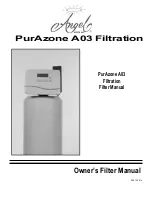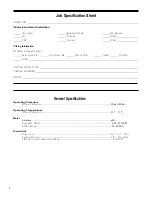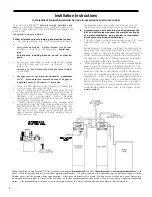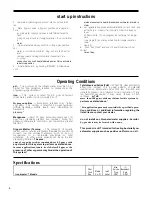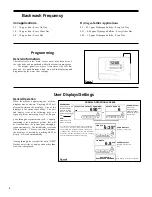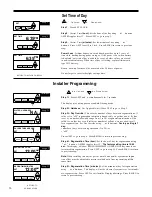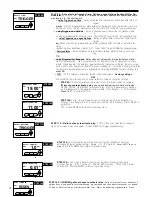
6
start up instructions
1.
Complete all plumbing connections; inlet, outlet and drain
line.
2. Place bypass valve in bypass position (see page 4).
Turn
on main water supply and open a cold filtered faucet to
flush
piping of any air and/or foreign material. Run until water
is
clear.
3. Open inlet valve slowly until it is in fully open position.
Let
water run to drain until clear. Plug unit into 120V outlet
and
remove cover and plug transformer connection into
4
‑
prong
connection on circuit board labeled power. Valve will return
to service position
4. Initiate backwash by holding "REGEN" button down
until
piston movement is heard. Backwash until water at drain is
clear.
5.
Let regeneration proceed automatically to fast rinse and
air recharge. Head of air should at least be down to
level
of filter media. If not, program air recharge for longer
time
(see page 10) and relay activation for longer duration
(see
page 11).
6. Push "Set Clock" and use UP and DN arrows to set
correct
time of day.
Operating Conditions
pH
— The pH level of the influent water must be 7.0 or
higher for iron oxidation reaction to proceed per the
engineering specifications.*
Iron
— This system is rated for 6.0 ppm of ferrous
(clear water) and/or ferric (red water) iron.*
Hydrogen Sulfide
— Sometimes referred to as "rotten
egg" odor. This system is rated for 5.0 ppm hydrogen
sulfide. Hydrogen sulfide levels vary depending on
barometric
pressure.*
Manganese
— Limit 1.0 ppm; amounts present over 1.0
ppm may gradually prevent iron removal. Note: For
optimum manganese reduction, pH should be greater
than 8.5.*
Organic Matter (Tannins
) – The presence of organic
matter such as tannins will prevent the oxidation process of
convert
-
ing the dissolved element, such as iron or
manganese, to a nonsoluble precipitate or solid
substance. In other words, organics can tie up the iron
preventing filtration.
The pres-
ence of organics such as tannins above 0.5 ppm voids
any claims for this system to perform as stated above.
In some applications, tannin levels below 0.5 ppm or the
presence of other organics may hinder the operation of
this system.*
Total dissolved Solids (TdS)
— While TDS does not directly
affect iron removal, it is a good indicator of potential
interfer
-
ence. Most waters have TDS less than 500 and
generally present no problems to iron reduction. If any
ion becomes excessive, it may cause failure of iron
removal.
a TdS
more than 500 ppm voids any claims for this system to
perform as stated above.*
*For application parameters outside the specified opera
-
tion conditions or additional information regarding the
listed items, contact your dealer.
do not install on chlorinated water supplies - harmful
by-products may be formed with ozone.
This product is nOT intended for treating bacterially un-
safe water supplies such as positive coliform or e. coli.
Specifications
Iron
blaster™ Models
Filter
Tank
Size
Media
Cu. Ft
Inlet/
Outlet
Max.
Service
Flow
GPM
(1)
Backwash
Rate
GPM
Summary of Contents for PurAzone A03
Page 1: ...PurAzone A03 Filtration PurAzone A03 Filtration Filter Manual Owner s Filter Manual 2013 2014...
Page 5: ...5 Figure 2 Figure 4...
Page 14: ...13 NEXT to go to Step 15S...
Page 18: ...17 RETURN TO NORMAL MODE...
Page 20: ...16 NEXT to go to Step 10CS...
Page 34: ...28...

